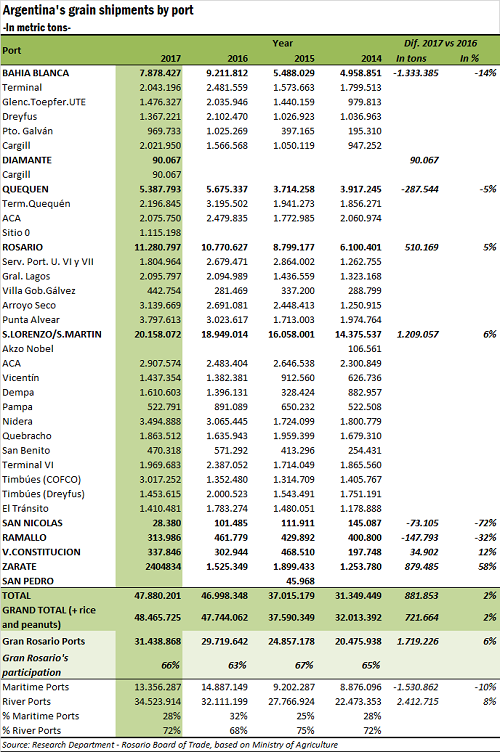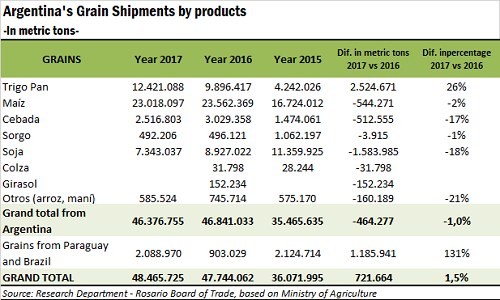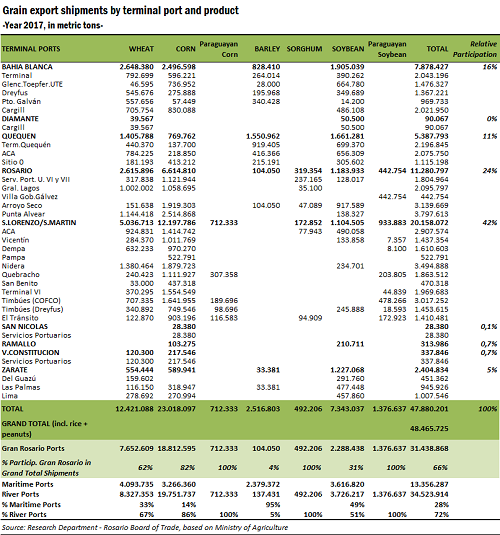Grain shipments grew in 2017, greater participation of -Gran Rosario-
JULIO CALZADA - EMILCE TERRÉ
According to official sources, shipments of grain from Argentina grew by 1.5% in 2017 reaching 48.4 million tonnes. The participation of the terminals of the Gran Rosario also increased in those shipments, 66% of the grains shipped in 2017 came out from this area (29.7 Mt). On the other hand, at the country level, shipments of wheat abroad tripled in the last two years. Furthermore, corn represented 50% of the Argentine shipments. Indicator No. 1: Argentina shipped 1.5% more grain in 2017, compared to the previous year. It went from 47.7 Mt in 2016 to 48.4 MT last year. In 2017, grain shipments abroad from all the Argentine port terminals amounted to 48.4 million tons (Mt), exceeding by 720 thousand tons the volume registered in 2016 and almost 16 Mt the record of the year 2014, three years ago. This can be observed in table No. 1. Having almost 11 Mt more grain shipments than 2 years ago is an excellent indicator for Argentina and its Commercial Balance. Remember that in 2015 the shipments were 37.5 Mt. We computed in this indicator the sum of shipments of the following grains: wheat, corn, soybeans, sorghum, barley, rapeseed, sunflower, rice, peanuts and others. We use official information provided by the Ministry of Agribusiness of the Nation.
Indicator No. 2: In 2017 the participation of the port terminals of the Gran Rosario grew. 66% of the grains shipped last year came from that area, going from 29.7 Mt to 31.4 Mt between 2016 and 2017. In 2017, shipments of grain from all the port terminals of the Gran Rosario amounted to 31.4 million tons (Mt), exceeding by 1.7 Mt the volume of 2016 (29.7 Mt). In this way, the participation of the Gran Rosario in the total of national shipments went from 63% in 2016 to 66% in 2017 (see table N ° 1). The port terminals of the "Southern Zone of the Gran Rosario" saw their shipments grow by 5% in 2017. They shipped 11.2 Mt in 2017 against the 10.7 Mt in 2016. We refer to those located on the south of the Paraná River, from Rosario to Arroyo Seco. Such is the case of "Servicios Portuarios S.A." which operates Unit VI and VII, "Cargill" in Villa Gobernador Gálvez and Punta Alvear, "Dreyfus" in General Lagos and "Toepfer" in Arroyo Seco. Those of the "North Zone of the Gran Rosario" increased their shipments by 6% in 2017. They shipped 20.1 Mt in 2017, compared to 18.9 Mt in 2016. The ports of the "Northern Zone of the Gran Rosario" are located towards the north of the urban area of Rosario and include the terminals located in the cities of San Lorenzo, Puerto General San Martín and Timbúes. They are "Molinos" (San Benito), "Vicentín" and "ACA" in the city of San Lorenzo; "Bunge" (Pampa and Dempa docks), "Toepfer" (Transit), "Nidera" (now Cofco), "Cargill", and "Terminal 6 S.A." in Puerto General San Martín; "Dreyfus", "Cofco" and "Renova S.A.", in Timbúes. The ports of Bahía Blanca and Quequén, on the other hand, recorded drops in their shipments last year. The Bahía Blanca terminals shipped about 1.3 Mt less grain (from 9.2 Mt in 2016 to 7.8 Mt in 2017), which implies a 14% drop in year-on-year terms. Similar downward phenomenon registered Quequén, although milder than Bahía Blanca: from 5.6 Mt dispatched in 2016 to 5.3 Mt in 2017, about 300 thousand tons less shipped. Indicator No. 3: Wheat has tripled its shipments abroad in the last two years, going from 4.2 Mt in 2015 to 12.4 Mt in 2017.
Table No. 2 shows the remarkable growth in wheat shipments in the last three years. It is important to note that in 2015, cereal remission abroad reached 4.2 million tons (Mt). In 2017, this figure tripled to 12.4 Mt. A really important record. The factors that explain this improvement are the following: a) The elimination of taxes and restrictions on exports arranged by the current national government in December 2015, measures that openly discourage wheat production and sales abroad. b) The improvement in export conditions in wheat resulted in a liquidation of stocks accumulated during previous cycles that explains the leadership of this grain in the percentage growth of national shipments. c) A large increase in national production in the last two years was verified by the measures adopted by the government and the accompaniment of the producers who invested heavily in the crop. This greater offer of the cereal made the shipments abroad grow strongly. In the 2015/2016 campaign, the national production of wheat stood at 10.9 Mt, while in the last cycle of 2017/2018, according to our institution's Strategic Guide for Agriculture, around 17.5 Mt were harvested, 60% more in just 2 years. This greater availability of cereal had a strong impact on shipments of merchandise abroad. d) Although the export data for wheat flour are not included in this report, the increased production and milling of the cereal in the last two years transformed our country into the fourth world exporter of wheat flour. In previous notes of the weekly news we analyzed that wheat bread milling during the 2016/2017 campaign amounted to 5.8 Mt, which was the highest value in five years and was above the milling average of the five campaigns included. Between 2011/12 and 2015/16 (5.6 Mt). This growth in wheat milling was accompanied by an even greater increase in exports of flour and other by-products that derive from this production process. Data collected by the INDEC indicate that exports of wheat flour in the 2016/2017 campaign reached 700,000 tons, 26% more than the previous season (2015/2016) and more than four times those registered in 2012 / 2013, campaign in which a very bad harvest and where the quantitative restriction of exports (ROE) governed. Indicator No. 4: The corn represented 50% of the Argentine shipments Corn is the most relevant product in terms of shipments of grain exports in Argentina. Measured in tonnes, in 2017 close to 50% of grain exports were corn. We are talking about a total of 23 Mt of corn in 2017, a figure very similar to that reached the previous year. If we look at the data for 2015, we will see that 16.7 Mt were sent abroad in that year. In two years, Argentina increased its export shipments by 6.3 Mt of corn per year. This implies a growth of almost 38% in the exports of this cereal. The factors that generated this rise were: a) As in wheat, the key and decisive factor was the elimination of export duties (DEX) and restrictions on exports (REX). This generated a shortening of the gap between the FOB price and the FAS value; and therefore an increase in the participation of the producer in the export business. The higher gross and net margins of the crop allowed a significant increase in the planted area, which went from 4.5 million ha in the 2014/2015 cycle to 6.4 million ha in 2017/2018. Almost 2 million additional hectares planted. b) As a result, the national corn production grew by almost 10 Mt in 2 years. It went from almost 28 Mt in 2014/2015 to 38 Mt in 2016/2017 according to GEA data (Strategic Guide for Agriculture). This increased production translated into increasing exports and dispatches of corn to other countries. Indicator No 5: The year-on-year fall of 18% in soybean shipments was more than offset by growth in wheat and stability in corn. In 2017, soybean shipments fell compared to the previous year in the aggregate total of Argentine ports. 7.3 Mt of soybeans were shipped in 2017 compared to 8.9 Mt in 2016. The fall was almost 1.6 Mt. But this decrease was offset by the almost 2.5 Mt more of wheat that was embarked on 2017. Meanwhile, corn remained stable at around 23 Mt of dispatch abroad, both in 2016 and in 2017. Question and indicator No. 6: Which were the terminal ports that sent more grains in Argentina last year? The Cargill terminal in Punta Alvear (Gran Rosario), followed by the COFCO terminal (former Nidera) in Puerto San Martín. In table N ° 3 grain shipments per terminal and product can be analyzed in 2017. It shows that the Cargill terminal in Punta Alvear occupied the first place in the ranking with almost 3.8 Mt embarked. The second place corresponded to the terminal of COFCO in the former Nidera of Puerto General San Martín in the Gran Rosario (3.5 Mt dispatched).
Question and indicator No. 7: What grains and what volume was shipped from the Gran Rosario's ports in 2017? This question can be answered by looking at table N ° 3. From the port terminals of the great Rosario was dispatched in 2017: 82% of corn shipments: 18.8 Mt left from the Gran Rosario in 2017. 62% of national shipments of wheat: about 7.6 Mt. 31% of national soybean shipments: 2.2 million tons. 100% of national shipments of sorghum: 492 thousand tons. 100% of the soybeans and corn that arrived from Paraguay / Bolivia in barge trains along the Paraná River. 4% of national shipments of barley: 104 thousand tons. This grain has a natural outlet through the ports of Bahía Blanca and Quequén. These specific indicators per product plus the fact that 66% of the national shipments clearly show the significance and importance of Gran Rosario as a port node exporter of grains in Argentina.


